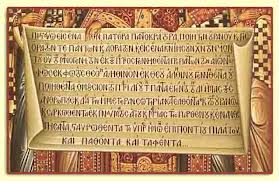What About Christian Creeds?

Creeds in the Church
Throughout the history of the Lord’s church creeds have been used; first as a teaching tool and second as a cohesive element of the community. This is because the Creed is first - the bases of the didactic, and second - the substance of what the candidate at baptism declares to be his, or her, own faith.
The word “Creed” is from the Latin credo: I believe. In this sense it is primarily an individual’s statement of faith. However, when we move beyond one’s personal relationship with the Creed it takes on a life force that extends itself far into the life of the Christian community.
LIFE STAGES OF THE CREED: One may see six definite life stages of the Creed in the Christian community.
First, as stated before, the Creed is the basis of catechesis in that it exists in, and as, a formal statement.
Second, the candidate at baptism declares the Creed to be his, or her, faith, and may reasonably expect to be questioned on his, or her, understanding of its tenets.
Third, all communicants confessing the selfsame Creed are united into a visible Church by their common affirmation.
Fourth, the Creed, thus confirmed, becomes the test of orthodoxy for the community.
Fifth, the orthodoxy established by the Creed becomes the denunciation of heresy.
Sixth, and finally, the common creedal acceptance becomes the basis for the apostolates of the community.
VALIDITY OF THE CREED: Because some would oppose the use of creeds, a word should be said here concerning their validity in the Lord’s Church.
In that a creed may be use to formally put forth false (as well as true) doctrine, it may be an agent of evil, as well as good. However, this is not to sit aside the creed as a God given tool of discipleship and communal cohesiveness.
Then there are those who would ascribe to the adage, “No creed but the Bible.” To those of this mindset it should be pointed out that this too is a creed. So then, even those who would oppose formal doctrinal statements in the form of creeds are, themselves, ardent subscribers to a creed.
CREEDS OF THE OLD COVENANT (TESTAMENT): The Creeds of the Lord’s Church are seen to have grown out of the first formal list of God’s requirements for His covenant people, the Jews. Of course, I speak of the Decalogue (see Exodus 20:3-17).
Exodus 20: 3-17. “You shall have no other gods before Me. “You shall not make for yourselves an idol, or any likeness of what is in heaven above or on the earth beneath or in the water under the earth. “You shall not worship them or serve them; for I, the LORD your God, am a jealous God, visiting the iniquity of the fathers on the children, on the third and the fourth generations of those who hate Me, But showing lovingkindness to thousands, to those who love Me and keep My commandments. “You shall not take the name of the LORD your God in vain, for the LORD will not leave him unpunished who takes His name in vain. “Remember the sabbath day, to keep it holy. “Six days you shall labor and do all your work, “But the seventh day is a sabbath of the LORD your God; in it you shall not do any work, you or your son or your daughter, your male or your female servant or your cattle or your sojourner who stays with you. “For in six days the LORD made the heavens and the earth, the sea and all that is in them, and rested on the seventh day; therefore the LORD blessed the sabbath day and made it holy. “Honor your father and your mother, that your days may be prolonged in the land which the LORD your God gives you.“You shall not murder. “You shall not commit adultery. “You shall not steal. “You shall not bear false witness against your neighbor. “You shall not covet your neighbor’s house; you shall not covet your neighbor’s wife or his male servant or his female servant or his ox or his donkey or anything that belongs to your neighbor.”
Truly, the Decalogue presents itself as the fountainhead of all other statements of faith.
After the Decalogue, one need look no further (for the evidence of creedal forms) than that all important passage from Deuteronomy 6:4-7 known the world over, and throughout all ages, since it’s writing as the Shema. (See numbers 15:37-41 and Deuteronomy 11:13-21.)
Deuteronomy 6: 4-9
“Here, Oh Israel! The LORD is your God, the LORD is one!
“And you shall love the LORD your God with all your heart and with all your soul and with all your might.
“And these words, which I am commanding you today, shall be on your heart;
“And you shall teach them diligently to your sons and shall talk of them when you sit in your house and when you walk by the way and when you lie down and when you rise up.
“And you shall bind them as a sign on your hand and they shall be as frontals on your forehead.
“And you shall write them on the doorposts of your house and on your gates...”
The Shema (so called for the first word of the text: “hear”) was what every covenanted person was to “hear.” It was written on the doorposts of their houses, and as frontlets worn on their foreheads and phylacteries bound to their arms. It was the credo of the Israelite of the Old Testament and continues to be so for the Orthodox Jewish persons of today. The Shema constitutes the first utterance heard as a newborn and the last upon the lips of devout Jews departing this life.
DECLARATIONS OF FAITH AS FOUNDATIONS TO CREEDS: Moving to the New Testament one many very well see the seeds of formal statements of faith in the proclamations of three of our Lord’s apostles: namely, Nathaniel (also called Bartholomew), Peter, and Thomas.
- In John 1:49 Nathaniel declared: “Rabbi, You are the son of God; You are the King of Israel.”
- In Matthew 16:16 Peter confessed: “Thou art the Christ, the Son Of the Living God.” (See Micah 5:2; Isaiah 9: 6.)
- From John 20:28 one reads of Thomas’s statement of Faith: “My Lord and my God!”
All three of these apostles give testimony in their proclamations of the deity of Jesus.
Both Nathaniel and Peter acknowledge Jesus as the “Son of God.” Apart from the paternal aspect of His birth from the Holy Spirit and Mary, we should consider the term “Son of God” at a more profound level. This title (as used by Nathaniel and Peter) should not only be understood in terms of a paternal father-son relationship, but rather, as one is the “son of” an attribute. James and John (the sons of Zebedee) are said to be the “Sons of Thunder” (Mark 3:17); Paul’s traveling companion, Barnabas, has a name which means “Son of Consolation” (Acts 5:36). In the Middle East one who lives in the desert is called a “Son of the Desert.” In this sense the term “son” is the manifestation of the essence which one is a son of. Thus, Jesus termed the “Son of God” meant that He was the physical manifestation of the very essence, nature, and being of God. The Jews of the first century understood this, even if twenty-first century Christians do not. The Jews of Christ’s day sought to kill Him because He claimed God (Yahweh) was His Father; “making himself equal with God” (John 5:18). The Jews said it plain enough in John 10:33, “For a good work we do not stone You, but for blaspheming; and because You, being a man, make Yourself out to be God.” Jesus had just told them (from verse 25 to verse 30) that God was His Father.
Moreover, Nathaniel refers to Christ as “the King of Israel” (John 1:49). Nathaniel, being familiar with the Psalms, knew that Yahweh was the only King of Israel (see Psalms 10:16; 24:7-10; 44:4; 89:18 , etc.). Therefore, Nathaniel acknowledges Jesus as Yahweh!
When Peter recognizes Jesus as “the Christ” (Matthew 16:16) he is acknowledging Him as the Mighty God of Israel. Peter knew the prophet Isaiah had written of the Messiah in this manner: “For a child will be born to us, a son will be given to us; And the government will rest up one His shoulders; And His name will be called Wonderful Counselor, Mighty God, Eternal Father, Prince of Peace” (Isaiah 9:6); nor, had Micah escaped his notice when that prophet had written that the Messiah (Christ) would be the eternal One (see Micah 5:2).
Finally, the Apostle Thomas confessed for himself, and respectively for all believers, that Jesus of Nazareth, Mary’s baby boy, is “My Lord and My God” (John 20:28). Because of his confession he received the Lord’s commendation: “Because you have seen Me, have you believed?” Then Jesus pronounces a blessing on all who would ascribe to the credo of Thomas: “Blessed are they who did not see and yet believed.”
Early Evidence of Creeds
Apostolic Formulas
APOSTOLIC FORMULAS OF FAITH: One must acknowledge that some years passed between the birth of the Church, on the day of Pentecost (A.D. 30), and the writing of the New Testament scripture. We know, for instance, that the book of James was written around A.D. 50 with the epistles of Paul soon afterwards, and the Gospels even later. The point is: by the time written scripture begin to make its rounds in the Christian community The Faith had ALREADY been established by the oral instructions of the apostles and their surrogates. In fact, the epistles are replete with evidence of preexisting formal doctrinal formulas which were drawn upon for the writing of the New Testament scriptures. This evidence suggest preexistent Christian formulae in both creedal and hymnal structure.
It seems more than abundantly clear that some type of formal confession of faith, such as - a creed, is reflected in Hebrews 10:23 where the writer states:
“Let us hold fast the confession of our hope without wavering, for he who promised is faithful;”
The KJV renders this verse thus:
“Let us hold fast the profession of our hope without wavering; (for he is faithful that promised;)”
Scriptural evidence that formal confessions established orthodoxy among Christians is common enough throughout the Pauline letters. The following is a list of that evidence:
First: The apostle Paul admonishes his son Timothy to, “Retain the standard of sound words which you have heard from me, in the faith and love which are in Christ Jesus.” The KJV reads, “Hold fast the form of sound words, which thou hast heard of me, in faith and love which is in Christ Jesus” (2 Timothy 1:13). Here, the Greek word translated “standard” in the NASB, and “form” in the KJV is hupotuposis (Strong’s #NT5296); means: a sketch (figure) for imitation: - form, pattern. Paul references a “sketch” a “pattern” of “sound words” to be imitated among believers. This BODY of “sound words” was formulated - therefore: a formula of doctrinal belief.
Second: The Apostle references the same formula in Romans 6:17 where he addresses the Roman Christians and says: “But God be thanked, ..., but ye have obeyed from the heart that form of doctrine which was delivered you” (KJV). The NASB reads almost the same way: “But thanks be to God ..., you became obedient from the heart to that form of teaching to which you were committed...” Here, the word translated “form” is the Greek word tupos (Strong’s #NT5179) which means: a stamp..., a shape, i.e. a statue, ... a model, ...en-(ex)ample, fashion, ... form, ... pattern,...” So, here too, the doctrine which the Roman’s had “obeyed from the heart” was delivered unto them in a shape, a model, to be imitated; it was in a pattern; a stamp. This formula was in place and establishing apostolic orthodoxy BEFORE the New Testament canon was available to the Romans, or anyone else for that matter.
Third: In both 1 Timothy 6:20 and 2 Timothy 1:14, Paul urges Timothy to keep the parakatatheke (par-ak-at-ath-ay-kay) (Strong’s #NT3872) - “deposit” that was committed unto him. The “deposit” to which Paul referred was the “form of sound words” that Timothy is admonished to “hold fast” in 2 Timothy 1:13; and is this “form of sound words” that the young Timothy is instructed to “commit ... to faithful men, who shall be able to teach others also” (2 Timothy 2-2).
Fourth: In the letters of First and Second Timothy Paul mentions the “faithful words”. Obviously this is a reference to the sayings that were common currency in the Christian community. Therefore, before we pass from the topic of a “form of sound words” we should, at least, give cursory attention to the “faithful words” passages of First and Second Timothy. The list that follows is a record of the “faithful words” of the pastoral epistles:
- First Timothy 1:15 and following, “This is a faithful saying, and worthy of all acceptance, that Christ Jesus came into the world to save sinners, of whom I am chief. ...” (KJV)
- First Timothy 3:1 and following, “This is a true saying, If a man desire the office of a bishop, he desirous of good work. ...” (KJV)
- First Timothy 4:8-9, “For bodily exercise profiteth little: but godliness is profitable unto all things, having promise of the life that now is, and of that which is to come. This is a faithful saying and worthy of all acceptation.” (KJV)
- Second Timothy 2:11 and following, “It is a faithful saying: For if we be dead with him, we shall also live with him....”(KJV)
In the Scriptures given above (called “The Faithful Words Passages”) it is discerned that formulas of words were common currency among the first Christians. These “sayings” were universally known and accepted as true. This knowledge should go a great distance in helping the student of Church history understand the use of formulas of faith to establish orthodoxy before the canon of Scripture was written.
CONFESSIONS OF FAITH: Once introduced to the Pauline epistles, the student of Holy Scripture soon sees the importance of confessions of faith and the central position held by these confessions in the life of the first Christian community. The Apostle instructs Timothy to: “Fight the good fight of faith; take hold of the eternal life to which you were called, and you made the good confession in the presence of many witnesses.” (1 Timothy 6:12). From his instructions to his son Timothy, Paul has told us four things:
- That Timothy was “called” to eternal life (see Romans 1:7 “called to be saints;” 8:28 “to them who are called according to his purpose;” see also 8:30; 9:24; 1 Corinthians 1:9 1:26; Galatians 1:6; 1:15; 5:13; Ephesians 4:4; Colossians 3:15; 1 Thessalonians 2:12; 2 Thessalonians 2:14; 2 Timothy 1:9; 1 Peter 1:15; 2:9; 2:21; 5:10; 2 Peter 1:3; Jude 1:1; Revelation 17:14; 19:9).
- That he made a confession of faith regarding that eternal life which he was called unto. (See Romans 10:1 “... if you confess with your mouth Jesus as Lord, and believe in your heart that God raised him from the dead, you shall be saved.” 1 John 4:15 “Who ever confesses that Jesus is the Son of God, God abides in him, and he in God.” 2 John 7, “ For many deceivers are entered into the world, who confessed not that Jesus Christ is come in the flesh....” (KJV).
- Timothy’s confession was made publicly before many witnesses. One recalls the words of Jesus recorded by Matthew in his Gospel chapter 10, and verse 32, “Everyone therefore who shall confess Me before men, I will also confess him before My Father who is in heaven.” (See Revelation 3:5 “... and I will confess his name before My Father, and before He is Angels.” See also Luke 12:8 “And I say to you, everyone who confesses Me before men, the Son Of Man shall confess him also before the angels of God;”).
- Lastly, Timothy’s confession was said, by Paul, to be “ten kalen homologian;” literally, “The Good Confession.” The definite article “ten” before “kalen homologian” (good confession) declares Timothy’s confession to have been a particular confession. Not simply “a” good confession, but “the” good confession. A Definite (Particular) One! One would expect the requirement of a particular confession to be in keeping with apostolic thought, in light of all the Apostle Paul taught concerning: holding “fast the confession of our hope” (Hebrews 10:23); holding “the form of sound words” (2 Timothy 1:13); and the need to guard “the good deposit” (1 Timothy 6:20 and 2 Timothy 1:14).
THE ELEMENTS OF THE CONFESSION: The basic creedal elements of the “Good Confession” may be ascertained from the essential tenets of the Christian faith, as these tenants appear in creedal language throughout Paul’s letters. The confession would naturally give assent to the gospel Paul preached. This gospel was rather simple and straightforward; it comprised five basic elements:
- The deity of Jesus Christ;
- The fact of the death of Christ;
- The fact of his burial;
- The fact of his resurrection;
- The necessity of a confession.
Paul writes clear enough in Romans 10:9-10, “... if you confess with your mouth Jesus as Lord, and believe in your heart that God raised Him from the dead, you shall be saved; for with the heart man believes, resulting in righteousness, and with the mouth he confesses, resulting in salvation.”
The above five elements are deposited in creedal form in key locations throughout the Pauline epistles. As examples, one might notice the following:
- Concerning the deity of Jesus: Colossians 1:15-19; 2:9-10; 1 Timothy 3: 16.
- Concerning the death and burial of Jesus: Romans 6:4; Col 2:12.
- Concerning the resurrection of Jesus: 1 Corinthians 15:3-4.
- Concerning confession: Romans 10:9-8; reflected in Hebrews 10:23; see also 1 Timothy 6:20 with 2 Timothy 1:4, and 2 Timothy 1:13.
ORTHODOXY: Although it is true that first century orthodoxy is not so easily identified in twenty-first century Christianity, it, nonetheless did exist and was established by the Lord’s apostles. It is to that orthodoxy that all true disciples of Jesus Christ must strive to attain. That such orthodoxy did (and does) exist is apparent from such New Testament passages as: 1 Corinthians 15:3, “For I delivered to you as a first importance what I also received.” The orthodoxy that Paul is here passing on to the Corinthians was the tradition he had received from earlier Christians; it had been established before his ministry began. This is seen earlier in his letter to the Corinthians (11:23) where he is giving instruction on the Lord’s Supper and writes: “For I received from the Lord that which I also delivered to you,...” Paul wrote this before any of the Gospels were written; he, therefore, received it by oral tradition in the form of a faithful pattern that was passed on. This “form of sound words” which comprises the “good deposit” was the agent of establishing apostolic orthodoxy. The first century believers were admonished to “hold fast the form” (formula, pattern) “of sound words” (2 Timothy 1:13). The writer of Hebrews urges to “let us hold fast the confession of our hope...” (Hebrews 10:23). The same writer observes that, “for we have become partakers of Christ, if we hold fast the beginning of our assurance firm until the end;” (Hebrews 3:14). The writer of Hebrews is simply echoing in verse 13 what he had written in verse 6: “... but Christ was faithful as a Son over His house -- whose house we are, if we hold fast our confidence and the boast of our hope firm until the end.” Jude, in his epistle “to those who are the called, beloved in God the Father, and kept for Jesus Christ,” writes; “Beloved, while I was making every effort to write you about our common salvation, I felt the necessity to write you appealing that you contend earnestly for the faith which was once for all delivered to the saints.” (Jude vv1&3). Both the apostles Paul and Jude (the half-brother of our Lord) writes concerning our “assurance” and “confidence” in the “faith that was once and for all delivered to the saints” and admonishes all Christians everywhere of the importance of holding to the original “assurance” and “confidence” in the faith that was delivered complete in the very beginning.
The orthodoxy of the apostles was the absolute test of fellowship for biblical Christianity; this is stated emphatically in Galatians 1:6-9 were Paul writes to those “foolish Galatians” who had departed from the true faith “for a different gospel.” Those who would preach “a different gospel” were anathema (accursed) from the faith of Christ, Paul wrote. Furthermore, the Ephesian letter speaks plainly when it states: “There is one body and one Spirit, just as also you are called in one hope of your calling; one Lord, one faith, one baptism, one God and Father of all who is over all and through all and in all” (Ephesians 4:4-5).
The “good confession” (1 Timothy 6:12, compare to: Hebrews 10:23) which established the apostolic orthodoxy of the first century is recalled in the above texts which are worded in formal creedal language.
Apostolicaly Speaking
☩ J L Hayes








